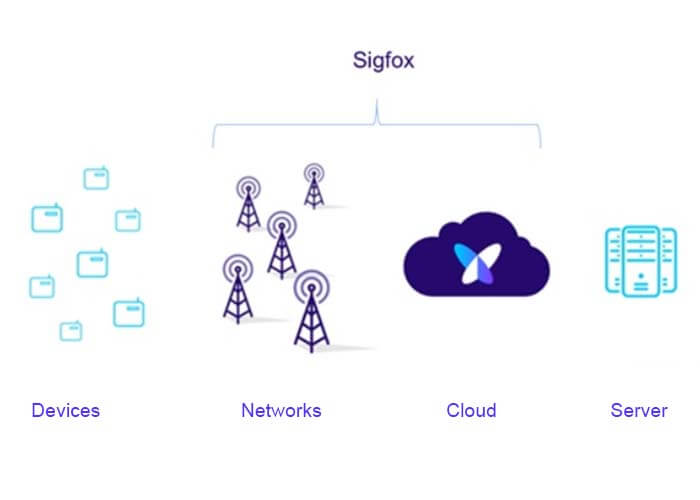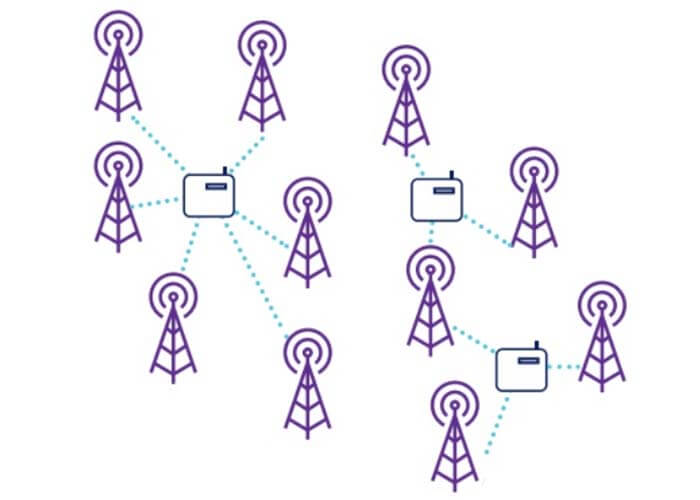What is the Sigfox technology?
Sigfox technology is a narrowband (or ultra-narrowband) technology. It uses a standard radio transmission method called binary phase-shift keying (BPSK), and it takes very narrow chunks of spectrum and changes the phase of the carrier radio wave to encode the data.
Sigfox technology deploys Low Power Wide Area Networks (LPWA) globally to provide Internet of Things (IoT) connectivity services. User devices integrate RF modules or chips that support the Sigfox protocol and connect to the Sigfox network after opening the connectivity service.
As shown in the figure below, user devices send Sigfox technology protocol packets with application information, and nearby Sigfox base stations are responsible for receiving and sending packets back to the Sigfox cloud server, which then distributes the packets to the corresponding client-server, which parses and processes the application information to realize wireless connection from the client device to the server.

Figure 1 Sigfox topology diagram
Sigfox technology is a low-cost, reliable, low-power solution for connecting sensors and devices. It is dedicated to connecting millions of physical devices and making the Internet of Things really happen through a dedicated low-power wide area network.
Features of the Sigfox technology protocol
Low power consumption
Extremely low energy consumption for extended battery life, with typical battery-powered devices operating for up to 10 years.
Ease of use
There is no configuration process, connection request, or signaling between the base station and the device. Devices are up and running in minutes!
Low cost
From the Sigfox RF module used in the device to the Sigfox network, Sigfox optimizes each step to make it as cost-effective as possible.
Small messages
User devices are allowed to send only very small packets: up to 12 bytes.
Interoperability
Sigfox technology principle
UNB (Ultra-Narrow Band) technology
Sigfox technology uses a common frequency band of 192 kHz spectrum bandwidth to transmit signals, using ultra-narrow band modulation, with a transmission width of 100 Hz per message and at a data rate of 100 or 600 bits per second, depending on the network configuration of the area.
UNB technology allows Sigfox base stations to communicate over long distances without being susceptible to noise and interference. The frequency band used by the system depends on the region where the network is deployed.
For example, in Europe the band used is 868-868.2 MHz; in other parts of the world, the band used is 902-928 MHz, depending on the local laws and regulations that govern the deployment.
Random Access
Random access is a key technology for achieving high quality of service. The transmission between the network and the device is asynchronous. The device sends a message at a randomly selected frequency, and then sends two other copies at different frequencies. This use of frequency and time is called time and frequency diversity.
A 12-byte payload message is transmitted over the air in 2.08s at a rate of 100bps, and the Sigfox base station listens to the entire 192kHz spectrum, looking for UNB signals to demodulate.
Collaborative Reception
The principle of collaborative reception is that no end device is attached to a specific base station, unlike traditional cellular networks. Messages sent by a device can be received by any nearby base station, and the average number of receiving base stations in a real deployment is three.
This is called spatial diversity.

Figure 2 Device messages are received by multiple Sigfox base stations
Spatial diversity, together with temporal and frequency diversity, is also the main factor behind the high quality of service in the Sigfox network.
Short messages
In order to solve the problem of achieving low-cost long-range coverage and low-power limitations of end devices, Sigfox technology has designed a short message communication protocol. The size of the message can range from 0 to 12 bytes. 12 bytes of the payload is sufficient to transmit sensor data such as status, alarms, GPS coordinates, and even events such as application data.
We list some examples of payload sizes.
GPS coordinates 6 bytes
Temperature 2 bytes
Speed 1 byte
Target status information 1 byte
Activation holds information 0 byte
European regulations allow RF transmissions to occupy 1% of the common frequency band. This requirement is equal to six 12-byte messages per hour or 140 messages per day. Although regulations vary in other regions, Sigfox technology uses the same service standards.
For downlink messages, the size of the payload is fixed to 8 bytes. The vast majority of messages can be transmitted in 8 bytes. It is already enough to trigger an action, remotely manage a device, or set application parameters
The duty cycle requirement of the base station is 10%, which guarantees that each terminal device receives 4 downlink messages per day. The terminal can receive more messages if there are still extra resources available.
Two-way transmission
Downlink messages are triggered by the end device, and the Sigfox cloud server receives the message with the downlink trigger identifier from the device and negotiates with the client-server to send the downlink message. After the device sends the first frame of the triggered downlink message for the 20s, there will be a reception window with a maximum duration of 25s. The downlink frequency is the frequency of the first frame of the uplink message plus a known offset.
